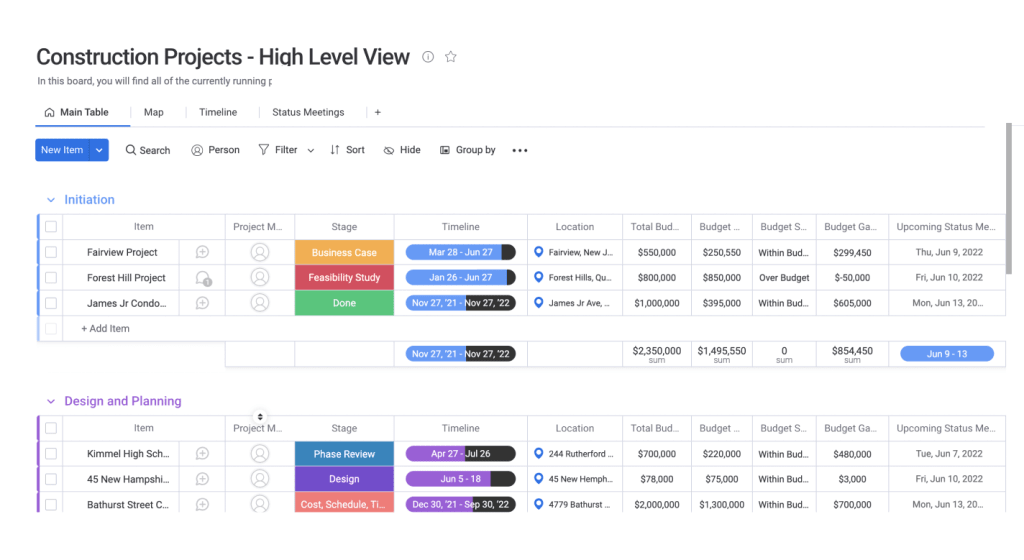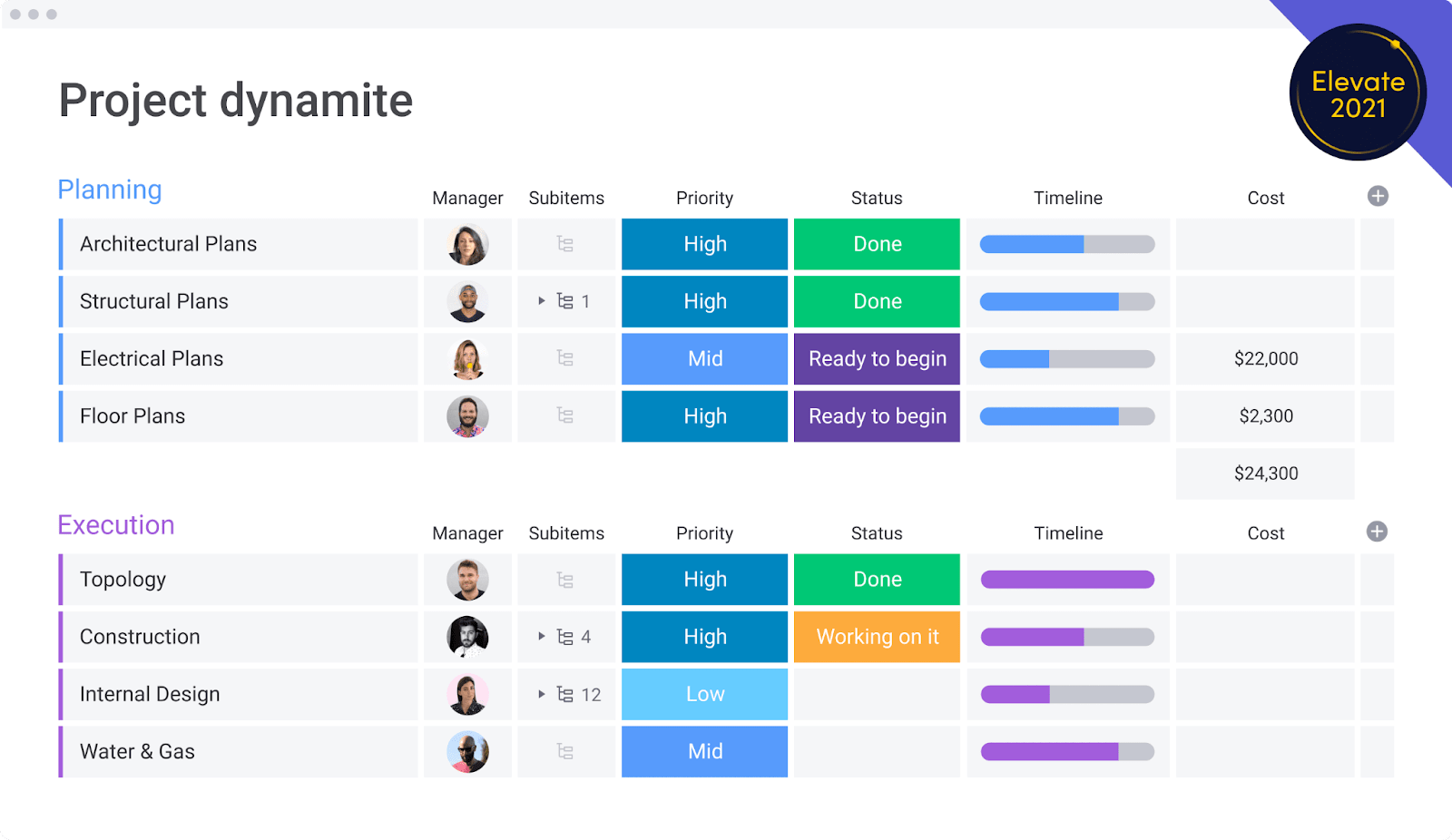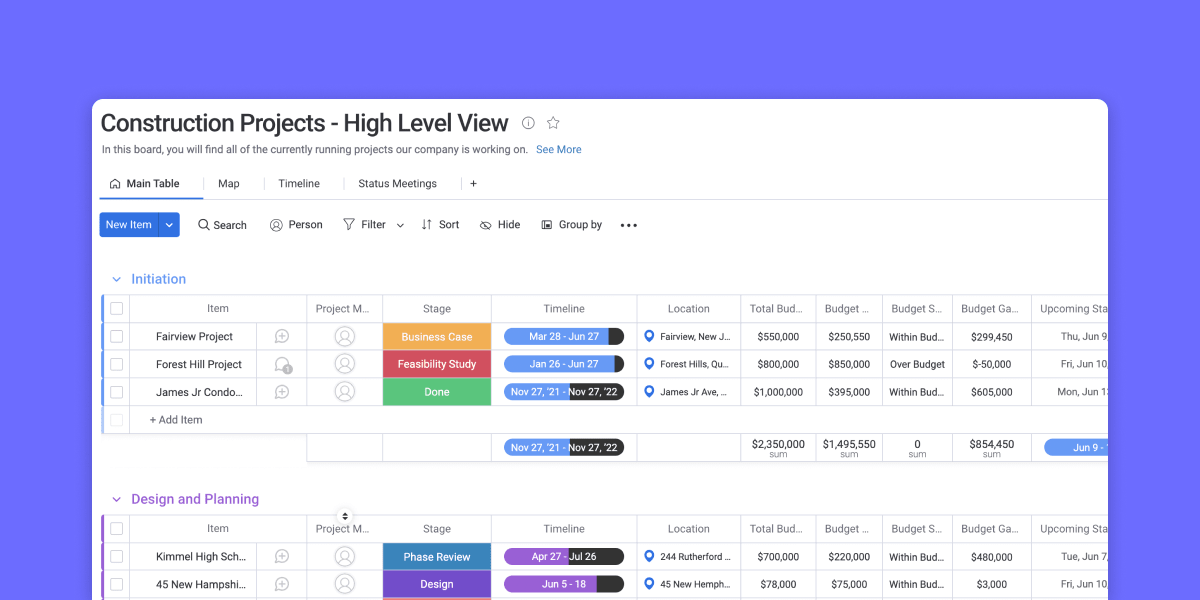Submitting an effective construction bid is crucial for any contractor who wants to stand out against the competition and win more proposals. But writing bids from scratch is a huge drain on resources, especially when you’re not guaranteed the job.
That’s why a construction bid template is a must for growth-focused contractors who want to save time and streamline the proposal process. In this article, we’ll explain what it is and how you can use a customizable construction bid template directly on monday.com to simplify the way you run your construction business.
What is a construction bid template?
A construction bid template lets you create a comprehensive construction bid without having to start from scratch every single time.A construction bid is a proposal submission for a potential construction project. When contractors send a bid to a potential customer, the document will usually include several important parts, such as:
- the scope of work
- a cost estimate
- required materials to get the job done
- project timeline and suggested work schedule
- terms and conditions for the project
- any additional information that’s specific to the project
Bids are common across the construction industry. Clients use bids to compare and choose from all available contractors. Bids can provide them with pricing information and different working methods and approaches. That’s why it’s important for construction companies to quickly and accurately churn out bids, which is where a template comes into play.
Why use a construction bid template?
If you run a construction company — or if you’re a project manager in that type of company — there are several reasons why you should consider using a construction bid form template when creating proposals.
First, bid templates help you make bids more quickly than starting from scratch. Less time spent on each bid means you’ll have time to send out more bids. In turn, this can help you cut the costs of the bidding process while increasing the number of potential projects your team can take on. If you’re a small team or a single contractor, you can reduce your admin time and spend more time on billable tasks. Crossing off new bids from your to-do list becomes much easier.
Additionally, construction bid templates let you establish a standard operating procedure (SOP) for the bidding process. This makes it easier to scale your construction company if you intend to do so. New hires can take over the bidding process without too much hassle since there’s already a solid process in place.
You’ll also have more time to customize bids to each project, which can help you win more clients. The bids you create can look more professional in less time and help you stand out from your competition.
Construction bid templates streamline work for your whole team. For instance, it’s much easier for a project owner to track your bid-hit winning ratio when you use a template directly on your Work OS — an open platform where anyone can create and shape the tools they need to run every aspect of their work.
You can connect it to your sales tracker instead of having duplicated data. Based on a survey of 2,000 construction companies, fewer than 6% track their bid-hit winning ratios. When you know your ratio, you can estimate how many bids you need to make to reach your goals, which allows you to forecast your revenue more accurately. Though not all construction companies have the exact needs, and thus, require different templates.
What are some examples of construction bid templates?
Let’s explore the types of construction bid proposal templates you can come across.
Residential construction bid template
A residential construction bid template is designed for residential projects. They’re usually simple enough for homeowners to understand since they’ll be the ones reading and comparing bids from different contractors. Some examples of residential construction projects include:
- roofing projects,
- new home constructions, and
- stucco projects.

Commercial construction bid template
Unlike residential projects, commercial construction bid templates are designed for business owners and corporate representatives to read and compare. They’ll usually be more complex and include more sections than residential bids. Some examples of commercial construction projects include:
- retail stores,
- factories,
- warehouses, and
- sports facilities.

monday.com’s construction bid template
Streamline and simplify your entire bidding process with monday.com’s free construction bid template! With a bid template directly loaded onto your Work OS, it’s much easier to generate and send more high-quality bids with less effort.
On monday.com Work OS, you can track the status of each bid and add reminders to follow up with potential customers after a set amount of time. You can also transform winning bids into project management boards, which lets you seamlessly move from proposal to execution.

But that’s only the tip of the iceberg. Because your construction bid template lives on your Work OS, you can create the tools you need to make the bidding process easier for your specific needs. Let’s say you want each project to have a specific profit margin. You could bake this in your template directly.
For instance, if you want all projects to have a 25% profit margin, you could add a formula in your template that adds this margin on top of your costs. The rest of the template can calculate labor costs, the cost of materials, and more. This means you wouldn’t have to calculate what price to quote yourself.
Aside from the above, there are plenty of other ways to use monday.com’s template to improve your bottom line.
Construction bid template tips & tricks
Here are some ways you can make the most of your construction bid templates on monday.com.
1. Use your construction bid template to forecast resources
Have you ever won too many projects at once and found yourself low on labor to execute those projects? You can mitigate this risk by forecasting your resources directly on your Work OS.
Add a column in your construction bid template for how many people a project would need. Then, connect this to a board on your Work OS that manages how many people you have available to execute a project.
When you create a bid, your resource allocation forecast will update automatically. You can make sure you don’t bid on too many projects and overextend your team.
2. Add a priority column
Some construction teams see some bids as a higher priority than others. So, in the case of limited sources, you’d want your team to spend more of their time on the higher priority bids — following up with the potential client, for example.
Keep track of which bids are what priority by adding a priority column in your construction bid template. Instead of that knowledge being stuck in your head, everyone on your team will know which projects are most important to the company — so they can act accordingly.

3. Implement your construction bid template in a CRM
A CRM software can help you keep track of each potential deal in your sales pipeline. With a single glance, you can see which potential clients are in which stages, such as:
- new lead,
- bidding in process,
- bid sent,
- follow-up sent,
- in negotiation,
- bid lost, and
- bid won
Keeping track of what stage each client is in will help you and your team take the right action with each prospect. With all that in mind, you might still have some questions about construction bid templates.

FAQs about construction bid templates
Here are the answers to some of the most common questions about construction bid templates.
1. How do you write a construction bid?
When you have a construction bid template, writing a construction bid is easy. First, import your template on monday.com if you haven’t already. Next, customize the scope of work, materials, and other details based on the project you’re bidding for.
Before you send the construction bid to a potential client, make sure you calculate cost and time estimates accurately. Double-check that the numbers make sense. Bidding too high will make you less competitive. Bidding too low can cause you to lose money on a project.
2. How do you create a bid sheet in Excel?
It’s possible to create a bid sheet in Excel, although it’s more time-consuming than using a template on monday.com Work OS. You’ll need to create a column for every section you want, but you’ll also need to add design elements yourself to make it look professional. In addition, you’ll need to insert the right formulas to calculate the cost of the project.
3. What should a construction bid include?
What a construction bid includes will vary for different types of construction projects. For instance, commercial projects may need insurance papers. But an eco-home renovation could require documentation to explain to clients how to apply for incentives.
4. How do you write a good construction proposal?
Here are some tips to help you stand out from your competitors when you write and send a construction proposal. First, be as specific as you can in your scope of work to avoid confusion. Any confusion can hurt the trust potential customers have in you.
You should also clarify the cost of the materials required to give the client a complete picture of the price. They’ll want to know where their money is going and why it costs what it costs.


